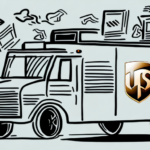How to Correct Next Day Air Saver Undeliverable Return Shipping Charges with UPS
Running an e-commerce business demands a deep understanding of shipping logistics, especially when it comes to timely and reliable shipping services. Accurate shipping charges are paramount; even minor inaccuracies can lead to undeliverable return shipments and incur costly charges. This comprehensive guide navigates the complexities of UPS Next Day Air Saver Shipping Rates and provides solutions for correcting undeliverable return shipping charges.
Understanding the Importance of Accurate Shipping Charges
Accurate shipping rates are a cornerstone of successful e-commerce operations. Discrepancies, no matter how small, can lead to undeliverable return shipments, directly affecting your bottom line. Effective management of shipping charges ensures the prompt and reliable delivery of goods while minimizing unnecessary expenses.
Accurate shipping charges enhance customer satisfaction by balancing reasonable fees with profitability. Overcharging can lead to cart abandonment and lost sales, while undercharging may erode profit margins. Striking the right balance is crucial for maintaining both customer trust and business viability.
Moreover, shipping has environmental implications. Optimizing shipping routes, using eco-friendly packaging, and partnering with sustainable shipping carriers can reduce your carbon footprint. These practices not only benefit the planet but also resonate with environmentally conscious consumers, enhancing your brand’s appeal.
Common Reasons for Undeliverable Return Shipments
Undeliverable return shipments can stem from various factors, including:
- Incorrect Shipping Address: Errors in the recipient’s address can prevent successful delivery.
- Failed Delivery Attempts: Multiple unsuccessful delivery attempts can lead to returns.
- Compliance Issues: Non-adherence to UPS’s shipping policies may cause shipments to be rejected.
- Incorrect Shipping Charges: Misdeclared package weight or dimensions can result in undeliverable returns.
- Customs Clearance Problems: Missing documentation for international shipments can hinder delivery.
- Package Damage or Theft: Damaged or stolen packages may not reach the intended recipient.
- Recipient Refusal: Recipients may refuse packages due to unexpected shipments or damaged goods.
- Access Restrictions: Delivery locations with restricted access, such as gated communities, can impede successful delivery.
Addressing these factors proactively can significantly reduce the incidence of undeliverable return shipments.
Navigating UPS Next Day Air Saver Shipping Rates
UPS Next Day Air Saver offers expedited shipping options tailored for packages requiring swift delivery, including documents, small parcels, and perishable items. Understanding the pricing structure is essential for selecting the most cost-effective option.
Shipping rates are determined by package weight, dimensions, and destination. Rates may increase for deliveries to remote or hard-to-reach areas. To optimize costs, monitor UPS’s seasonal discounts and promotions, which can provide substantial savings on Next Day Air Saver shipments.
According to [UPS Rate Charts 2023](https://www.ups.com/assets/resources/media/en_US/rate_charts.pdf), businesses can achieve up to a 15% reduction in shipping costs by accurately calculating package dimensions and weight, emphasizing the importance of precise shipping data.
Analyzing Your UPS Shipping Invoices for Errors and Discrepancies
Regularly reviewing your UPS shipping invoices is critical to identifying and rectifying errors that could lead to undeliverable returns. Common discrepancies include:
- Missing Packages: Ensure all shipped items are accounted for.
- Incorrect Charges: Verify that shipping fees align with the declared weight and dimensions.
- Duplicate Charges: Watch for repeated billing of the same shipment.
Utilizing automated billing analysis software can streamline this process. Tools like UPS’s billing analysis features or third-party solutions can detect anomalies swiftly, reducing manual oversight and mitigating financial losses.
How to Request Refunds for Incorrect Shipping Charges with UPS
If inaccuracies in shipping charges are identified, prompt action is required to request a refund. Follow these steps:
- Contact UPS Customer Service: Initiate a refund request by reaching out to UPS directly.
- Submit a Claim Online: Use UPS’s online claim submission portal, providing necessary documentation such as shipping labels and invoice numbers.
- Adhere to Deadlines: Claims must be filed within 15 days of the invoice date to be eligible for a refund.
Ensure all required documentation is accurate and complete to expedite the refund process. Familiarize yourself with UPS’s refund policies to avoid missed deadlines and additional complications.
Tips for Preventing Undeliverable Return Shipments with UPS
Proactive measures can significantly reduce the likelihood of undeliverable returns:
- Verify Shipping Addresses: Double-check recipient addresses for accuracy before shipping.
- Select Appropriate Package Types: Use the correct packaging to accommodate the size and weight of your items.
- Comply with UPS Policies: Stay updated with UPS’s shipping guidelines to ensure compliance.
- Provide Contact Information: Include valid phone numbers and email addresses for recipients to facilitate delivery communication.
- Monitor Shipments: Use tracking tools to keep tabs on your packages and address issues promptly.
- Proper Packaging: Employ sturdy boxes and adequate packing materials to protect items during transit.
- Clear Labeling: Ensure all packages are clearly labeled with accurate delivery and return information.
Best Practices for Managing Your Shipping Costs with UPS
Effective shipping cost management enhances profitability and operational efficiency. Implement the following best practices:
- Establish a Shipping Budget: Allocate funds specifically for shipping to monitor and control expenses.
- Compare Carrier Rates: Regularly evaluate rates from different carriers to ensure competitive pricing.
- Optimize Package Dimensions: Use appropriately sized packages to minimize dimensional weight charges.
- Negotiate Rates: Leverage high shipment volumes to negotiate favorable rates with UPS.
- Utilize Alternative Shipping Methods: Consider ground shipping for non-urgent packages to reduce costs.
- Track and Analyze Expenses: Use analytics tools to monitor shipping expenditures and identify cost-saving opportunities.
Optimizing Your Returns Process to Minimize Errors and Delays
An optimized returns process is vital for minimizing undeliverable return shipments and enhancing customer satisfaction:
- Accurate Return Addresses: Ensure return addresses are correct and prominently displayed on packages.
- Clear Return Instructions: Provide detailed guidelines on how customers can return items, including preferred methods and locations.
- Multiple Return Options: Offer various return methods, such as in-store, drop-off points, and online pickups, to accommodate customer preferences.
- Transparent Returns Policy: Develop a comprehensive returns policy outlining timeframes, conditions, and procedures to prevent confusion and errors.
According to the [2023 Retail Returns Report](https://www.npd.com/wps/portal/npd/us/industry-expertise/retail/), streamlined return processes can reduce return-related costs by up to 20% and significantly boost customer loyalty.
The Role of Technology in Streamlining Your UPS Shipping Operations
Integrating technology into your shipping operations can enhance efficiency and accuracy:
- Shipping Software: Implementing advanced shipping software automates tasks, reduces errors, and provides real-time tracking. Solutions like shipping software offer features such as rate comparisons, label printing, and shipment tracking.
- Barcode Scanning: Utilizing barcode technology ensures accurate tracking and inventory management, minimizing shipping errors.
- Electronic Data Interchange (EDI): Automating the exchange of shipping information between your business and UPS reduces manual data entry and enhances processing speed.
Adopting these technological tools not only streamlines operations but also provides valuable data insights, enabling informed decision-making and continuous improvement.
How to File a Claim for Damaged or Lost Packages with UPS
Addressing damaged or lost packages promptly is essential to maintaining customer trust and business integrity:
- Fill Out a Claim Form: Access the claim form through the UPS website and provide all necessary details, including tracking numbers and descriptions of the damaged items.
- Provide Supporting Documentation: Submit evidence such as photos of the damage, proof of value, and relevant shipping documents.
- Submit Online: Use UPS’s online claim submission system for faster processing.
Once submitted, UPS will investigate the claim and work with you to resolve the issue, which may include refunds, replacements, or other appropriate remedies.
The Importance of Communicating Effectively with Customers About Shipping Policies and Procedures
Clear communication regarding shipping policies and procedures is crucial for minimizing misunderstandings and enhancing customer satisfaction:
- Order Placement Instructions: Provide straightforward guidance on how to place orders to prevent errors and ensure smooth transactions.
- Shipment Tracking: Offer tracking information and support to keep customers informed about their order status.
- Return Process Details: Clearly outline the steps for returning items, including timelines, conditions, and available methods.
Effective communication reduces the likelihood of disputes and returns due to confusion, fostering a trustworthy relationship with your customers.
How to Track Your UPS Shipments and Stay Informed About Delivery Statuses
Tracking your UPS shipments is essential for monitoring delivery progress and addressing any issues promptly:
- Use Tracking Numbers: Each shipment generates a unique tracking number, which can be used on the UPS website or app to monitor its status in real-time.
- Sign Up for Alerts: Enable email or text notifications to receive updates on your shipment’s progress and any delivery status changes.
- Integrate Tracking into Your Systems: Incorporate tracking capabilities into your e-commerce platform to provide customers with seamless updates.
According to UPS’s [2023 Shipping Trends Report](https://www.ups.com/us/en/services/trends.aspx), businesses that actively monitor and communicate shipment statuses experience a 30% increase in customer satisfaction rates.
Maximizing the Value of Your Shipping Data to Improve Operations and Customer Service
Leveraging shipping data can provide valuable insights into your business operations and customer behaviors:
- Analyze Shipping Trends: Identify peak shipping periods, common delivery issues, and cost drivers to optimize operations.
- Enhance Customer Service: Use data to personalize customer interactions, predict shipping needs, and proactively address potential issues.
- Implement Shipping Analytics Tools: Utilize dashboards and reporting tools to gain a comprehensive view of your shipping performance and make data-driven decisions.
By maximizing shipping data, businesses can streamline operations, reduce costs, and enhance the overall customer experience.
In conclusion, effective management of shipping charges is vital for the success of your e-commerce business. By closely monitoring your UPS Next Day Air Saver Shipping rates, analyzing shipping invoices for errors, and optimizing your returns process, you can minimize undeliverable return shipments and enhance both efficiency and customer satisfaction. Implementing the strategies and best practices outlined in this guide will empower you to take control of your shipping costs, refine your operations, and deliver an exceptional shipping experience to your customers.






















